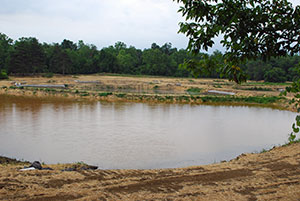Management of Lagoons and Settling Ponds
The Operator must ensure that suitable operating procedures are in place for the safe operation of excavations, tips and lagoons The operating procedures must specify: (a) The manner in which such activities are to be carried out, (b) The nature and extent of supervision of such activities, and (c) The protective measures to be taken during such activities to ensure the safety, health and welfare of any person and the safety and stability of the excavation, tip or lagoon. |  |
Lagoons and settling ponds need special consideration and regular inspection should be carried out to ensure that they remain safe. A lagoon and settling pond should be designed so that it is never over full and needs to take account for sustained periods of heavy rainfall. Every lagoon and settling pond should have an emergency overflow which is 1metre below the minimum bund wall. The bund wall must be of sufficient strength to withstand forces created during sustained periods of heavy rainfall. If appropriate lagoons and settling ponds should be lined to prevent leakage.
Lagoon and settling pond walls should have adequate drainage, edge protection and access arrangements and draw off points and pumps should be accessible.
Lagoons and settling ponds should not be positioned or placed so that catastrophic failure can endanger people or structures that lie below it or would be severely affected by such a failure.
Pumping equipment must be easily accessible for maintenance and operation and procedures must be in place to ensure the safety of persons carrying out maintenance. You must consider how maintenance staff can get out to floating pontoons, and submersible pumps.
The person responsible for carrying out inspections of a lagoon or settling pond must have the competence to know when further appraisals, assessments and remedial measures are necessary.
It is important to protect against trespass around lagoons and where trespass has been observed or is evident then appropriate security measures and other actions should be taken to deter trespass. The lagoon/settling pond should have appropriate signage and rescue equipment in the event of an incident.
While it is a good idea to have vegetation it should be controlled so that the inspections can be easily and speedily carried out.
Burrowing animals will severely affect the integrity of the lagoon and should be discouraged or taken into account in the design
Additional information on the safety of stockpiles, tips and lagoons can be found in Part 6 of the SAFE QUARRY GUIDELINES TO THE SAFETY, HEALTH AND WELFARE AT WORK (QUARRIES) REGULATIONS 2008.